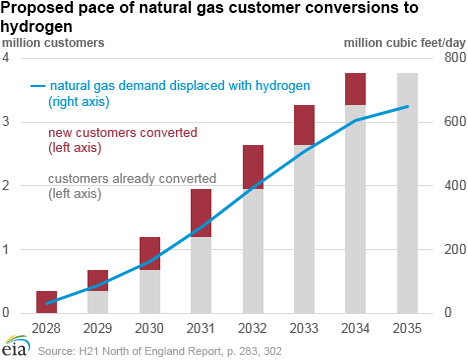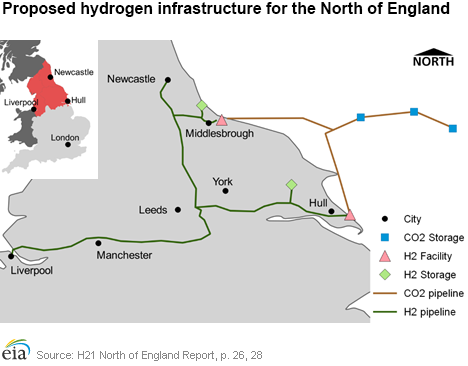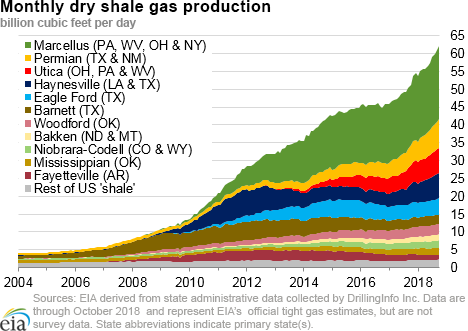In the News:
In Europe, utilities look to repurpose their assets in a low-carbon future
Driven by the European Union’s (EU) commitment to reducing fossil fuel consumption and greenhouse gas (GHG) emissions, European natural gas utilities are looking to hydrogen as a way to de-carbonize and extend the life of their distribution networks.
EU’s near-term goals for 2030 include a reduction in GHG emissions by at least 40% relative to a 1990 baseline. Beyond 2030, EU’s Energy Roadmap 2050 calls for a reduction in GHG emissions of 80% to 95% relative to the 1990 baseline. The United Kingdom (UK), although currently in the process of leaving the EU, remains committed to the 80% GHG emissions reduction target through its Climate Change Act of 2008. Given these goals, natural gas pipeline networks may be increasingly underutilized unless new uses are found.
European natural gas grid operators are considering several plans to displace natural gas consumption with hydrogen. The H21 North of England (NoE) partnership is likely to be the first to fully displace natural gas consumed in residences and businesses. The proposed conversion of nearly four million homes and businesses to hydrogen across a region of the UK spanning Leeds, Liverpool, Manchester, and all points north up to the Scotland border would result in displacing an estimated 650 million cubic feet per day (MMcf/d) of natural gas demand—nearly 9% of the UK’s total. UK utilities Cadent and Northern Gas Networks, along with Norwegian energy producer Equinor, are partners in the project.
Hydrogen will be produced from natural gas feedstock through methane reforming—separating the co-produced carbon dioxide (CO2) for carbon capture and sequestration (CCS). Equinor will then move the CO2 by dedicated pipelines to geologic storage locations throughout the North Sea. Project sponsors estimate the total cost of the entire effort at a little less than $29 billion (October 10 exchange rate).
Should H21 NoE’s plan achieve its full scale, total natural gas consumption for hydrogen production would reach more than 860 MMcf/d, and the project would capture and sequester nearly 250 million metric tons of CO2 annually. Project sponsors see potential for meeting UK’s Climate Change Act goals in the future through the gradual conversion of other regions from natural gas.
Overview:
(For the Week Ending Wednesday, December 12, 2018)
- Natural gas spot prices fell at most locations this report week (Wednesday, December 5 to Wednesday, December 12). Henry Hub spot prices fell from $4.62 per million British thermal units (MMBtu) last Wednesday to $4.20/MMBtu yesterday.
- At the Nymex, the price of the January 2019 contract decreased 33¢, from $4.469/MMBtu last Wednesday to $4.136/MMBtu yesterday. The price of the 12-month strip averaging January 2019 through December 2019 futures contracts declined 8¢/MMBtu to $3.165/MMBtu.
- Net withdrawals from working gas totaled 77 billion cubic feet (Bcf) for the week ending December 7. Working natural gas stocks are 2,914 Bcf, which is 20% lower than the year-ago level and 20% lower than the five-year (2013–17) average for this week.
- The natural gas plant liquids composite price at Mont Belvieu, Texas, rose by 6¢/MMBtu, averaging $6.73/MMBtu for the week ending December 12. The price of ethane and isobutane fell by 2% and 1%, respectively. The price of natural gasoline, propane, and butane rose by 5%, 1%, and 4%, respectively.
- According to Baker Hughes, for the week ending Tuesday, December 4, the natural gas rig count increased by 9 to 198. The number of oil-directed rigs fell by 10 to 877. The total rig count decreased by 1, and it now stands at 1,075.
Prices/Supply/Demand:
The Henry Hub average spot price declined as temperatures increased. This report week (Wednesday, December 5 to Wednesday, December 12), Henry Hub spot prices fell 42¢ from $4.62/MMBtu last Wednesday to $4.20/MMBtu yesterday. Prices have declined over the report week as a result of last week’s colder-than-normal weather that was followed by average or warmer-than-normal weather across most of the country. At the Chicago Citygate, prices decreased 49¢ from $4.48/MMBtu last Wednesday to $3.99/MMBtu yesterday.
Northeast prices declined in most markets but rose in New England. At the Algonquin Citygate, which serves Boston-area consumers, prices went up 19¢ from $6.96/MMBtu last Wednesday to $7.15/MMBtu yesterday. Temperatures in the New England Census division averaged 4°F lower than last year for the report week. Heating degree days in the New England Census division totaled 208, compared to 179 last year and a normal of 207 for this time of the year.
At the Transcontinental Pipeline Zone 6 trading point for New York City, prices decreased 60¢ from $4.99/MMBtu last Wednesday to $4.39/MMBtu yesterday.
Tennessee Zone 4 Marcellus spot prices decreased 34¢ from $4.33/MMBtu last Wednesday to $3.99/MMBtu yesterday. Prices at Dominion South in southwest Pennsylvania fell 32¢ from $4.29/MMBtu last Wednesday to $3.97/MMBtu yesterday.
Discount at Permian Basin trading hub narrowed but remains greater than $2.00/MMBtu. Prices at the Waha Hub in West Texas, which is located near Permian Basin production activities, averaged $2.12/MMBtu last Wednesday, $2.50/MMBtu lower than Henry Hub prices. Yesterday, prices at the Waha Hub averaged $1.99/MMBtu, $2.21/MMBtu lower than Henry Hub prices.
California prices decreased. Prices at PG&E Citygate in Northern California fell $1.99, down from $6.45/MMBtu last Wednesday to $4.46/MMBtu. Prices at the SoCal Citygate decreased $3.47 from $10.03/MMBtu last Wednesday to $6.56/MMBtu. As of December 4, according to PG&E, 2,900 customers remain without power compared to 12,000 customers who remained without power in November 16 as a result of the fire incident in Butte County on November 8.
Nymex front month futures prices increased to their highest levels since 2014. At the Nymex, the price of the January 2019 contract decreased 33¢, from $4.469/MMBtu last Wednesday to $4.136/MMBtu yesterday. The price of the 12-month strip averaging January 2019 through December 2019 futures contracts declined 8¢/MMBtu to $3.165/MMBtu.
Supply remains unchanged as imports from Canada made up for production declines. According to data from PointLogic Energy, the average total supply of natural gas remained the same as in the previous report week, averaging 92.6 Bcf/d. Dry natural gas production decreased by 1% this report week from 88.6 Bcf/d last report week. Average net imports from Canada increased by 27%, or 1 Bcf/d from 3.7 Bcf/d, last week. Daily volumes from Enbridge’s Westcoast pipeline, which provides natural gas to northwestern United States, have risen following the explosion in October. According to PointLogic, imports yesterday were 703 million cubic feet (MMcf) compared to 613 MMcf last Wednesday.
Demand rose. Total U.S. consumption of natural gas rose by 15% compared with the previous report week, according to data from PointLogic Energy. Natural gas consumed for power generation climbed by 9% week over week. Industrial sector consumption increased by 4% week over week. In the residential and commercial sectors, consumption increased by 26%. Natural gas exports to Mexico increased 2%.
U.S. LNG exports were flat week over week. Eight LNG vessels (six from the Sabine Pass liquefaction terminal, one from Cove Point, and one from Corpus Christi) with a combined LNG-carrying capacity of 26.2 Bcf departed the United States between December 6 and December 13, and one vessel was loading at Sabine Pass on Wednesday, according to Bloomberg shipping data.
Cheniere Energy, the developer of the Corpus Christi liquefaction facility in Texas, announced that the first commissioning cargo departed the terminal on December 11. Corpus Christi is the first greenfield liquefaction export facility built in the Lower 48 states and the first LNG export facility in Texas. The facility was placed in service several months ahead of the originally announced schedule.
U.S. LNG imports resumed. Two LNG cargoes were imported into the United States so far this month, one to Everett terminal in Massachusetts and one to Cove Point in Maryland. Both cargoes came from Trinidad. Before these imports arrived, the last LNG cargo imported into Everett came in November 2018 and to Cove Point in January 2018. The cargo imported into Cove Point in January was used as a cool down cargo as part of the commissioning process of the new liquefaction facilities.
Storage:
Net withdrawals from working gas storage fell below the five-year average for the first time in five weeeks. Net withdrawals from storage totaled 77 Bcf for the week ending December 7, compared with the five-year (2013–17) average net withdrawals of 79 Bcf and last year's net withdrawals of 59 Bcf during the same week. Working gas stocks totaled 2,914 Bcf, which is 723 Bcf lower than the five-year average and 722 Bcf lower than last year at this time.
Working gas stocks’ deficit to the five-year average decreased, and the deficit to the bottom of the five-year range increased. In the Lower 48 states, total working gas stocks are 427 Bcf lower than the five-year minimum, and every storage region is currently lower than the bottom of its five-year range. The deficit to the bottom of the range increased in all regions except the Pacific and South Central salt regions. As of this report week, the Midwest region is 58 Bcf (6%) lower than the five-year minimum, and the South Central region―including both salt and nonsalt facilities―is 182 Bcf (17%) lower than the five-year minimum.
The average near-month futures contract price is trading at a discount to the average spot price, which provides incentive for storage withdrawals. Price differences between the spot price and the futures price at the Nymex indicate economic incentives for withdrawals from working gas. During the most recent storage week, the average natural gas spot price at the Henry Hub averaged $4.52/MMBtu, and the Nymex futures price of natural gas for delivery in January 2019 averaged $4.44/MMBtu, 8¢/MMBtu lower than the spot price. A year ago, the January contract was 9¢/MMBtu higher than the spot price.
Reported net withdrawals into storage are below the median of analysts’ expectations. According to The Desk survey of natural gas analysts, estimates of the weekly net change from working natural gas stocks ranged from net withdrawals of 74 Bcf to 94 Bcf, with a median estimate of 82 Bcf. At the 10:30 a.m. release of the Weekly Natural Gas Storage Report, the price of the Nymex futures contract for January delivery at the Henry Hub fell 2¢/MMBtu to $4.46/MMBtu, with 98 trades executed. The price varied in subsequent trading, ranging between $4.25/MMBtu and $4.29/MMBtu.
Temperatures were higher than normal for the storage week. Temperatures in the Lower 48 states averaged 41 degrees Fahrenheit (°F), 1°F higher than normal and 5°F lower than last year at this time. Temperatures were similar to those reported for the previous week.
See also:
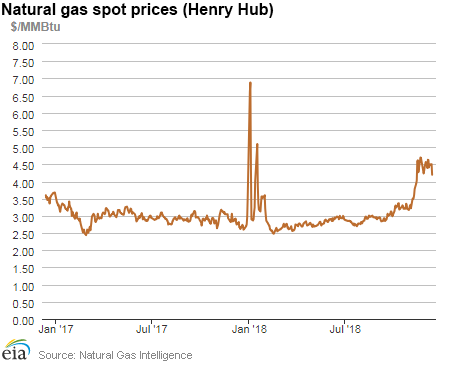
| Spot Prices ($/MMBtu) | Thu, 06-Dec |
Fri, 07-Dec |
Mon, 10-Dec |
Tue, 11-Dec |
Wed, 12-Dec |
|---|---|---|---|---|---|
| Henry Hub |
4.41 |
4.48 |
4.51 |
4.50 |
4.20 |
| New York |
4.67 |
5.44 |
5.35 |
4.74 |
4.39 |
| Chicago |
4.24 |
4.32 |
4.38 |
4.27 |
3.99 |
| Cal. Comp. Avg.* |
6.47 |
5.72 |
5.48 |
4.99 |
4.29 |
| Futures ($/MMBtu) | |||||
| January contract | 4.327 |
4.488 |
4.545 |
4.407 |
4.136 |
| February contract |
4.217 |
4.378 |
4.360 |
4.258 |
4.035 |
| *Avg. of NGI's reported prices for: Malin, PG&E Citygate, and Southern California Border Avg. | |||||
| Sources: Natural Gas Intelligence and CME Group as compiled by Bloomberg, L.P. | |||||
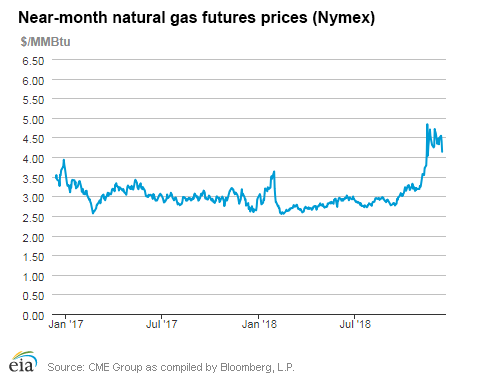
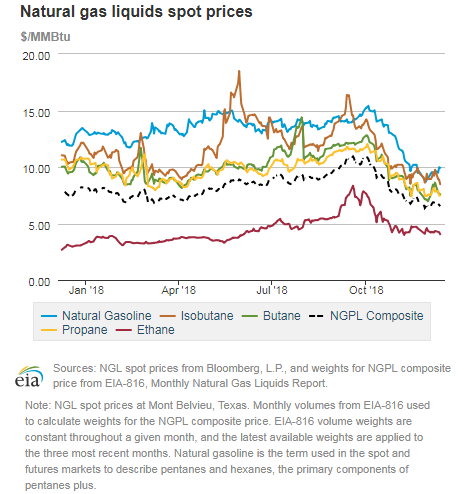
| U.S. natural gas supply - Gas Week: (12/6/18 - 12/12/18) | |||
|---|---|---|---|
Average daily values (Bcf/d): |
|||
this week |
last week |
last year |
|
| Marketed production | 97.9 |
99.1 |
87.2 |
| Dry production | 87.6 |
88.6 |
78.1 |
| Net Canada imports | 4.8 |
3.7 |
5.4 |
| LNG pipeline deliveries | 0.2 |
0.1 |
0.2 |
| Total supply | 92.6 |
92.4 |
83.7 |
|
Source: OPIS PointLogic Energy, an IHS Company | |||
| U.S. natural gas consumption - Gas Week: (12/6/18 - 12/12/18) | |||
|---|---|---|---|
Average daily values (Bcf/d): |
|||
this week |
last week |
last year |
|
| U.S. consumption | 95.2 |
83.0 |
89.2 |
| Power | 25.0 |
23.1 |
26.3 |
| Industrial | 24.5 |
23.7 |
24.2 |
| Residential/commercial | 45.6 |
36.3 |
38.6 |
| Mexico exports | 4.6 |
4.5 |
4.4 |
| Pipeline fuel use/losses | 8.2 |
7.4 |
7.7 |
| LNG pipeline receipts | 4.6 |
4.4 |
3.0 |
| Total demand | 112.6 |
99.4 |
104.3 |
|
Source: OPIS PointLogic Energy, an IHS Company | |||
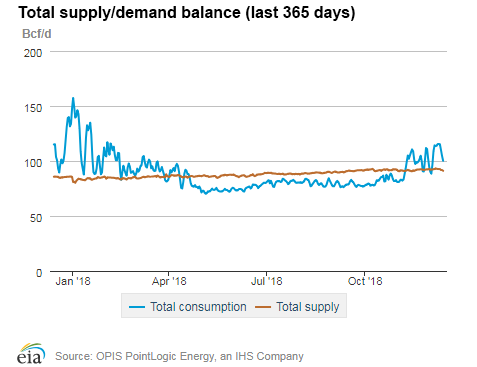
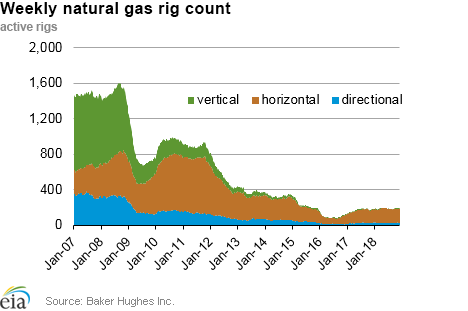
| Rigs | |||
|---|---|---|---|
Tue, December 04, 2018 |
Change from |
||
last week |
last year |
||
| Oil rigs | 877 |
-1.1% |
16.8% |
| Natural gas rigs | 198 |
4.8% |
10.0% |
| Note: Excludes any miscellaneous rigs | |||
| Rig numbers by type | |||
|---|---|---|---|
Tue, December 04, 2018 |
Change from |
||
last week |
last year |
||
| Vertical | 0 |
0.0% |
0.0% |
| Horizontal | 29 |
7.4% |
-6.5% |
| Directional | 72 |
5.9% |
1.4% |
| Source: Baker Hughes Inc. | |||
| Working gas in underground storage | ||||
|---|---|---|---|---|
Stocks billion cubic feet (Bcf) |
||||
| Region | 2018-12-07 |
2018-11-30 |
change |
|
| East | 732 |
752 |
-20 |
|
| Midwest | 885 |
914 |
-29 |
|
| Mountain | 160 |
168 |
-8 |
|
| Pacific | 238 |
253 |
-15 |
|
| South Central | 898 |
905 |
-7 |
|
| Total | 2,914 |
2,991 |
-77 |
|
|
Source: Form EIA-912, "Weekly Underground Natural Gas Storage Report" | ||||
| Working gas in underground storage | |||||
|---|---|---|---|---|---|
Historical comparisons |
|||||
Year ago (12/7/17) |
5-year average (2013-2017) |
||||
| Region | Stocks (Bcf) |
% change |
Stocks (Bcf) |
% change |
|
| East | 857 |
-14.6 |
856 |
-14.5 |
|
| Midwest | 1,037 |
-14.7 |
1,018 |
-13.1 |
|
| Mountain | 214 |
-25.2 |
207 |
-22.7 |
|
| Pacific | 306 |
-22.2 |
332 |
-28.3 |
|
| South Central | 1,222 |
-26.5 |
1,224 |
-26.6 |
|
| Total | 3,636 |
-19.9 |
3,637 |
-19.9 |
|
| Source: Form EIA-912, "Weekly Underground Natural Gas Storage Report" | |||||
| Temperature – heating & cooling degree days (week ending Dec 06) | ||||||||
|---|---|---|---|---|---|---|---|---|
HDD deviation from: |
CDD deviation from: |
|||||||
| Region | HDD Current |
normal |
last year |
CDD Current |
normal |
last year |
||
| New England | 208 |
1 |
29 |
0 |
0 |
0 |
||
| Middle Atlantic | 198 |
2 |
31 |
0 |
0 |
0 |
||
| E N Central | 211 |
-14 |
41 |
0 |
0 |
0 |
||
| W N Central | 245 |
-6 |
64 |
0 |
0 |
0 |
||
| South Atlantic | 129 |
-7 |
31 |
12 |
3 |
-2 |
||
| E S Central | 125 |
-16 |
28 |
1 |
0 |
1 |
||
| W S Central | 92 |
-12 |
36 |
7 |
4 |
-3 |
||
| Mountain | 227 |
16 |
57 |
0 |
0 |
-2 |
||
| Pacific | 124 |
13 |
30 |
0 |
-1 |
0 |
||
| United States | 174 |
-3 |
38 |
3 |
1 |
-1 |
||
|
Note: HDD = heating degree day; CDD = cooling degree day Source: National Oceanic and Atmospheric Administration | ||||||||
Average temperature (°F)
7-Day Mean ending Dec 06, 2018
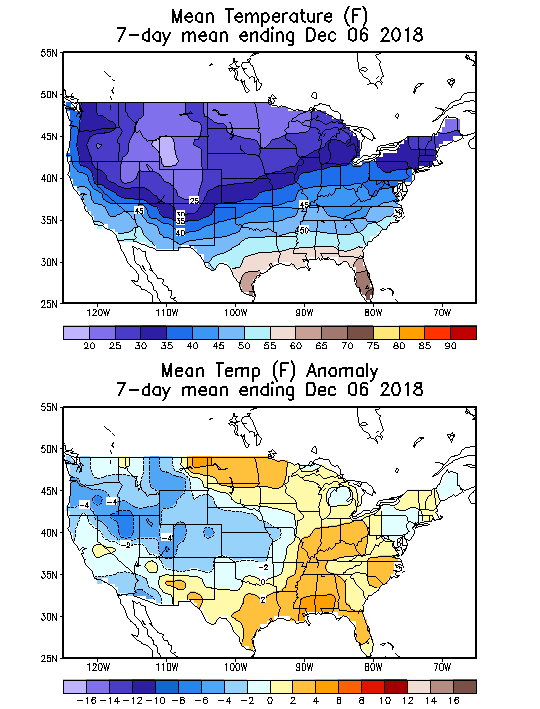
Source: NOAA National Weather Service
Deviation between average and normal (°F)
7-Day Mean ending Dec 06, 2018

Source: NOAA National Weather Service

